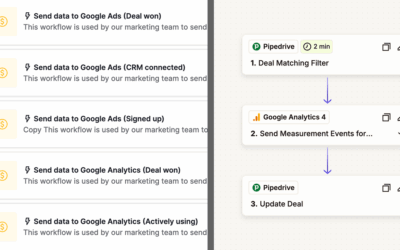Last updated: Oct 2, 2025
Most marketers send emails. Few actually nurture leads effectively. Real lead nurturing means knowing who’s warm, what message will move them forward, and how often to reach out.
In this guide, you’ll learn how to:
- Identify and score your warmest leads
- Craft messaging that pushes, pulls and reassures prospects
- Set a contact frequency that builds trust, not unsubscribes
Let’s take a look at each of these key elements of lead nurturing one by one.
Step 1: Identify and score your warmest leads
Let’s say your B2B marketing generated a good amount of leads. Are all of them ready to buy? Some are curious subscribers, others are sales-ready, and some will never convert. Your job is to sort them fast so sales reps spend time on the right people.
If you and your sales team don’t have a huge amount of time on your hands, the first few things you’ll want to know is…
- Who’s completely unqualified and irrelevant? You don’t want these people in your sales funnel, since they will only be frustrated and annoyed by unwanted interactions.
- Who’s slightly engaged? You want them to get more educated about your offering, before you spend your precious sales rep man-hours calling them.
- Who’s ready to buy? You want to know how to identify qualified leads immediately and prioritize them in your sales process.
This process is called lead segmentation. It’s all about figuring out where you should be directing your salespeople’s efforts. A simple and popular way of thinking about this is via the AIDA funnel – Awareness, Interest, Desire, Action.
The basic idea here is simply that you want to segment and score your leads – turn a big, undifferentiated group of unknowns and figure out who belongs where.
Once you have a decent idea, you want to make it as easy as possible for your leads to progress down the sales funnel. But how do you even develop this idea to begin with?
Effective lead segmentation and lead scoring with the help of marketing automation
Here, “effective” lead segmentation means not spending excessive amounts of time and energy on it.
A good place to start is with a simple email marketing campaign (later, you can expand to social media, ads, and more). The responses to your first outreach campaign can give you useful information about who your leads are, where they are in the buyer’s journey, and what they want.
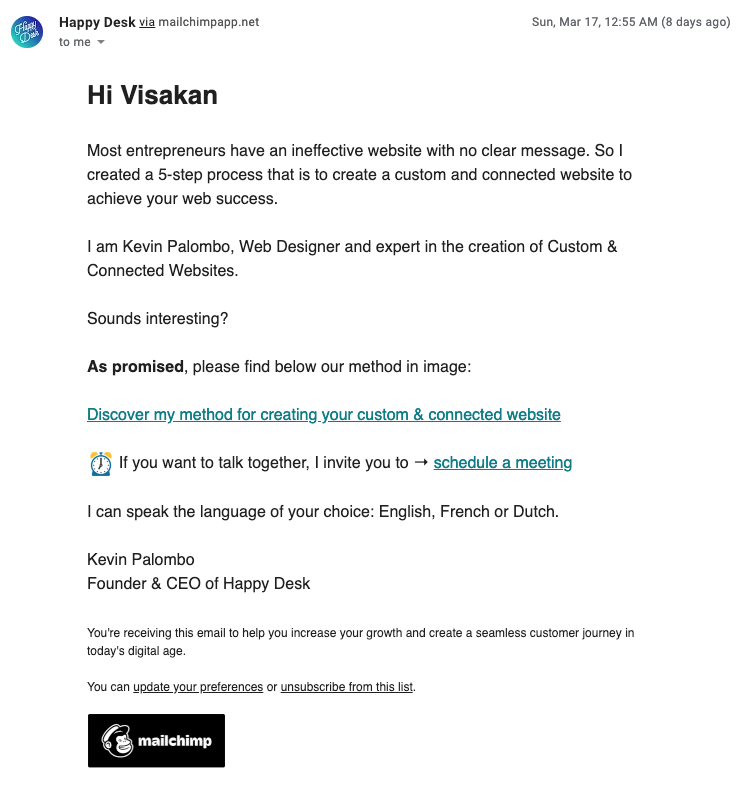
Consider the various responses a lead might have to the above email.
- They might not even open it. Perhaps they don’t check their email much, or it didn’t interest them and they simply archived or deleted it.
- They might open and hit unsubscribe. This is not necessarily a bad thing! You don’t want to be sending emails to people who don’t want to receive them.
- They might open and click through on the “learn more” link. This tells Happy Desk that their lead is definitely interested, though perhaps not ready to move ahead immediately.
- They might schedule a meeting. This is the desired outcome for this process – more meetings means more business!
With just one email, Happy Desk learns a lot about their leads, and develops clarity on what they should be doing next.
If you want to take it a step further, and make your lead segmentation sustainable and automated, then be sure to take on implementing a lead scoring system.
Each lead scoring software out there will be different, so be sure to implement what makes sense to you. But as a simple rule-of-thumb first describe your buyer and their common buyer journey. Then, set up basic scoring.
- You’ll want to increase the score for
- matching your buyer persona’s key elements (job title, seniority, age, etc.)
- visiting high-intent web pages such as your pricing page
- opening and clicking your lead nurturing campaigns
- engaging with marketing touchpoints such as webinars, downloads, gated content
- You’ll want to decrease the score for
- not matching your buyer persona’s key elements (job title, seniority, age, etc.)
- visiting web pages such as your jobs section
- not opening your lead nurturing campaigns, or even unsubscribing
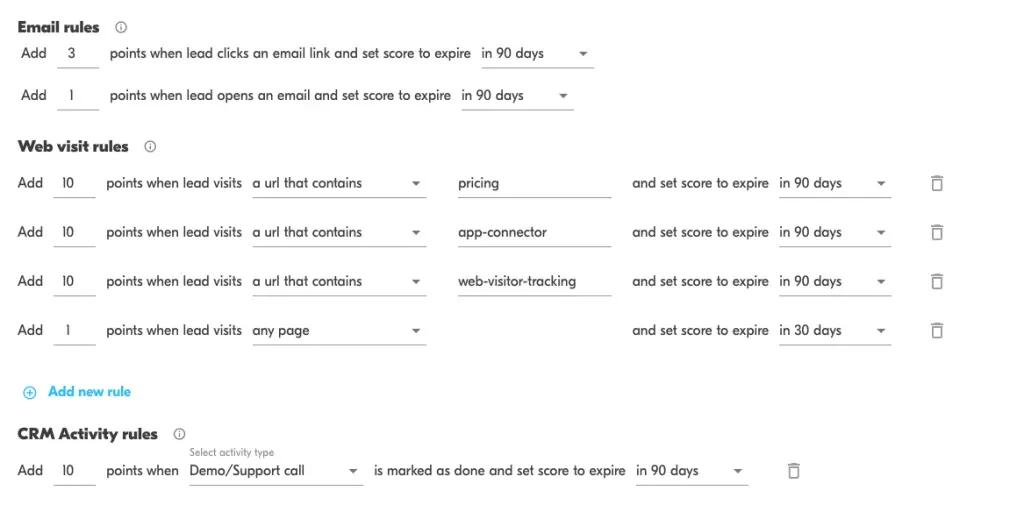
How do you avoid annoying all your leads, and getting marked as spam?
When it comes to email lead nurturing strategy, retargeting ads, direct mail, or any other automated lead nurturing tactics, there are two variables you want to think about. And they’re both really about being sensitive to your prospects’ needs:
- Messaging – what exactly should you be saying to your leads as a part of the lead nurturing program?
- Frequency – how often should you be sending these messages and sending follow up messages?
Let’s dig into the details.
Step 2: Craft messaging that moves leads forward
Use the Jobs-to-Be-Done model as a practical checklist. Every email or ad should do ONE clear job:
Isn’t it great when other people have thought long and hard about a challenge that you have, and you can learn from their thinking? In The Forces Of Progress, Alan Klement articulates the various forces at play that affect the progress of a new lead through the marketing funnel:
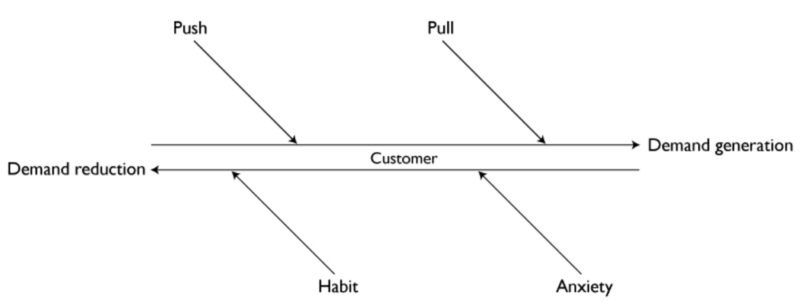
For any substantial change, all four forces need to be addressed!
Compellingly, Alan points out that “habits and anxieties are your silent competitors”. Framed another way, you could say that the lead nurturing process is all about effectively addressing your leads’ habits, pain points, and anxieties.
Use the Push / Pull / Habit / Anxiety model to plan each touchpoint
Every email, blog post, or ad should do one clear job for the lead.
1. Push — Surface the pain.
What is it about your leads’ existing solutions that is broken, ineffective, or frustrating?
Outfunnel example: “Your sales and marketing teams constantly let good leads slip through the cracks because your lead data is messy.”
2. Pull — Show the better future
What is it about your solution that will help your leads achieve their goals more effectively?
Outfunnel example: “Outfunnel syncs sales and marketing data so reps instantly see which leads engaged.”
We show them what’s possible when you align marketing and sales data.
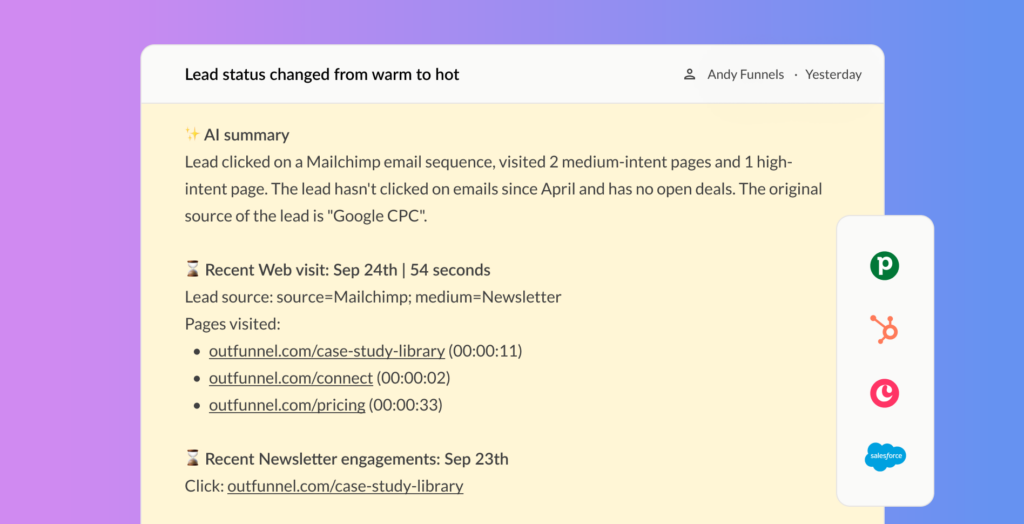
3. Habit — Call out current workflow
Often, most of us aren’t super deliberate about our habits, but we will recognize them when we see them described.
Outfunnel example: “Still exporting CSVs every week from your CRM to Mailchimp? Automate it.”
4. Anxiety — Remove risk.
Reassure buyers that your product will work and is safe to adopt.
Use case studies, testimonials, and social proof. Describe your processes and approach to quality. Show your expert credentials.
Outfunnel example: “Used and loved by 500+ revenue teams around the globe.”
Step 3: Find the right nurture frequency (and avoid spam)
The first and most important question is: have your leads opted-in to receive messages from you? If they have not, obviously they’re not going to take too kindly to receiving lots of messages and your email messages will start having issues with deliverability.
Next, what is the sales cycle for your product? How long does it typically take for someone to learn about your product, and to make a decision? If it takes many months, you’re probably going to want to space out your emails.
For some businesses, demand might even be seasonal. For example, if you’re selling Christmas lights in November, it might make sense to send emails almost daily. It wouldn’t make much sense to be sending those emails in February.
Of course, ultimately every customer base is different, and you need to figure out what’s the right tempo for your customers.
What about leads who have gone through your sales cycle and said no?
Lead nurturing is for them as well! If someone is not interested in scheduling a meeting to redesign their website right now, they might still be interested in learning more about the process.
The whole point of lead nurturing is to be useful to your potential customers, even and especially when they’re not ready to buy.
Even if they end up unsubscribing, you can put that “negative” email signal to work for you.
Conclusion: You can’t nurture leads without truly understanding them.
Segment and score first, speak to their pains and goals, and pace outreach thoughtfully. Then use automation to scale what already works — not to blast generic emails.
Are you nurturing your leads with marketing messages? Make sure you connect such data to your CRM to make the most out of your lead nurturing efforts. Try Outfunnel free for 14 days – it’s the easiest way to connect your sales and marketing data.



